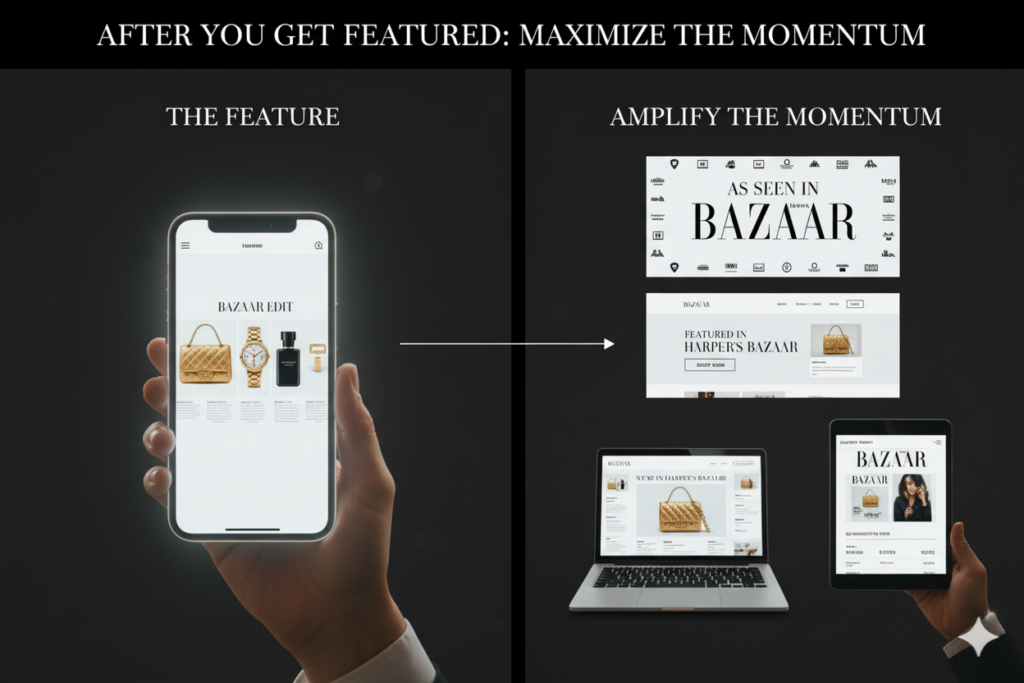Every brand dreams of the moment when its product graces the glossy pages of Harper’s Bazaar, one of the most iconic fashion and lifestyle magazines in the world. But here’s the truth: getting featured isn’t about luck. It’s about strategy, storytelling, and knowing exactly how to get published in Harper’s Bazaar.
If you’re serious about building credibility, visibility, and luxury positioning, this guide will walk you through everything you need to know — from crafting the perfect pitch to understanding what editors actually look for.
Why Harper’s Bazaar Features Matter for Brands
Being featured in Harper’s Bazaar magazine is more than just a PR win; it’s a reputation milestone. Here’s why:
1. Global Credibility and Trust
Harper’s Bazaar has shaped fashion culture for over 150 years. A feature or mention in the magazine acts as an endorsement that instantly elevates your brand’s authority.
2. High-Value Audience
The publication reaches a global audience of style-conscious readers, influencers, and buyers. Getting your brand noticed here means direct exposure to people who appreciate quality and luxury.
3. Long-Term Brand Equity
A Harper’s Bazaar media placement stays relevant far beyond the publication date; it becomes a badge of honor you can showcase on your website, packaging, and marketing materials.
Step-by-Step: How to Get Published in Harper’s Bazaar
Ready to make it happen? Here’s a structured approach to help your brand stand out and earn that coveted placement.
Step 1: Understand Harper’s Bazaar’s Editorial DNA
Before you submit your brand to Harper’s Bazaar, you need to understand what kind of stories and products they love.
Study their latest issues and website. Pay attention to:
- Product features in beauty, fashion, and lifestyle sections
- The tone of their editorials
- The brands and values they align with (sustainability, innovation, craftsmanship)
This will help you tailor your story to fit their editorial vision.
Step 2: Build a Strong, Newsworthy Angle
Editors at Harper’s Bazaar receive hundreds of pitches daily, so your product needs a hook. Ask yourself:
- What makes my brand unique?
- Does my story tie into a cultural or seasonal trend?
- Is there a “why” behind what I create?
For example:
Instead of saying “We sell handmade bags,” say “We create bags handwoven by rural artisans, blending traditional craftsmanship with modern design.”
That’s the kind of story that makes editors want to write about you and helps you appear in Harper’s Bazaar magazine organically.
Step 3: Prepare a Professional Press Kit
A well-designed press kit is your brand’s first impression. It should include:
- A short, polished brand story
- High-resolution product and lifestyle images
- Media mentions or testimonials
- Contact information and website links
Make sure your imagery looks editorial — clean, stylish, and aligned with the magazine’s visual standards. Poor visuals can ruin even the best pitch.
Step 4: Find the Right Editorial Contact
To get published in Harper’s Bazaar, you need to reach the right person. Most Harper’s Bazaar editions (like U.S., India, or U.K.) have section-specific editors, beauty, fashion, lifestyle, and digital.
Look for:
- The masthead of the publication
- LinkedIn profiles of editors
- Contributor pages on their website
Personalize your outreach. Avoid generic “Dear Editor” emails. Instead, write something like:
“Hi [Editor’s Name], I’ve been following your recent feature on sustainable fashion, and I believe our brand aligns perfectly with your editorial focus.”
That personal touch can make all the difference.
Step 5: Craft a Short and Compelling Pitch
Your email should be crisp, creative, and to the point. Here’s a format that works:
Subject: “Modern Skincare Meets Science – A Feature Idea for Harper’s Bazaar Beauty Section”
Body:
Hi [Name],
I’m [Your Name], founder of [Brand]. We specialize in [product category]. Our products are made with [unique value]. I noticed Harper’s Bazaar recently covered [related topic], and I’d love to share how we’re contributing to this conversation.
Attached is our media kit and product lookbook for your review. I’d be happy to send samples or additional information.
Warm regards,
[Name + Contact Info]
Keep it professional and easy to read. Editors appreciate clarity and relevance.
Step 6: Consider Partnering With a PR Agency
If you’re new to media outreach, collaborating with a PR expert can save time and increase your chances of success. Agencies experienced in Harper’s Bazaar media placements already understand editorial timelines, tone, and pitch formats.
They can also help you position your product in a way that appeals directly to Harper’s Bazaar’s editors and readers.
Common Mistakes to Avoid
Many brands fail to get featured because of these easily fixable issues:
- Sending mass, impersonal pitches
- Poor-quality or unprofessional photos
- Overly promotional tone (it’s not an ad!)
- Ignoring editor feedback or follow-up timing
Remember, you’re building a relationship, not just chasing a one-time mention.
After You Get Featured: Maximize the Momentum
Once your feature goes live, amplify it!
- Share it on your social channels
- Add the Harper’s Bazaar logo under your “As Seen In” section
- Include it in press releases, investor decks, and email campaigns
This not only builds credibility but also increases your conversion rates — readers trust brands endorsed by reputable media.

Final Thought
Learning how to get featured in Harper’s Bazaar isn’t just about publicity; it’s about positioning your brand where it truly belongs. When you focus on value, storytelling, and authenticity, your brand naturally stands out.
So, whether you want to submit your brand to Harper’s Bazaar or learn how to get published in Harper’s Bazaar, remember: consistency, clarity, and care are your strongest PR assets.
You’re not just pitching a product — you’re sharing a story the world deserves to see.
